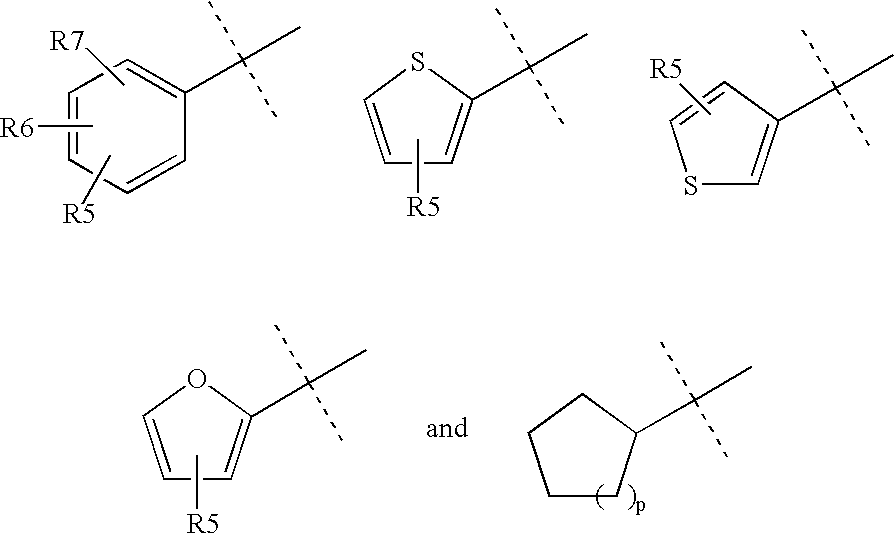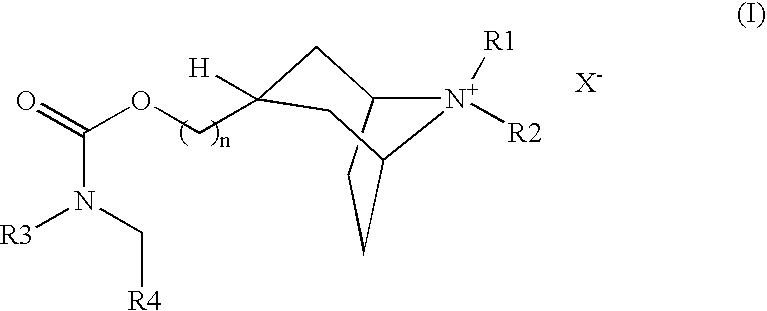Muscarinic Acetylcholine Receptor Antagonists
a technology of acetylcholine receptor and muscarinic acetylcholine, which is applied in the direction of biocide, drug composition, immunological disorders, etc., can solve the problems of airway hyperreactivity and hyperresponsiveness, relatively few anti-cholinergic compounds are available for use in the clinic, and the product is currently not available in the united states
- Summary
- Abstract
- Description
- Claims
- Application Information
AI Technical Summary
Benefits of technology
Problems solved by technology
Method used
Image
Examples
example 1
(3-endo)-8-azabicyclo[3.2.1]oct-3-ylmethyl (phenylmethyl)2-thienylcarbamate trifluoroacetate
[0120] To a solution of 1,1-dimethylethyl (3-endo)-({[(2-thienylamino)carbonyl]oxy}methyl)-8-azabicyclo[3.2.1]octane-8-carboxylate (220 mg, 0.6 mmol) in dry DMF (1 ml), 95% NaH was added at 0° C. The solution was stirred for 10 minutes and benzyl bromide (308 mg, 1.8 mmol) was added. The reaction mixture was allowed to warm to room temperature and stirred overnight. The combined organic layers were dried over Na2SO4 and evaporated under vacuum. The residual oil was mixed with 20% TFA in anhydrous dichloromethane (3 ml). The reaction mixture was stirred at room temperature for 30 min. then the solvent was removed under reduced pressure. The residue was purified by Gilson HPLC, eluting with acetonitrile / water / 0.1% TFA (10 / 90 to 90 / 10, v / v, over 10 min) to give the title compound (254 mg, 90%). LC / MS: m / z, 357 (M+H), 1.53 min.
example 2
(3-endo)-8,8-dimethyl-3-[({[(phenylmethyl)(2-thienyl)amino]carbonyl}oxy)methyl]-8-azoniabicyclo[3.2.1]octane iodide
[0121] (3-endo)-8-Azabicyclo[3.2.1]oct-3-ylmethyl (phenylmethyl)2-thienylcarbamate trifluorocaetate was dissolved in ethyl acetate (50 ml) and washed with saturated sodium bicarbonate (2×20 ml) and water (2×20 ml). The organic layer was dried over Na2SO4, filtered and evaporated. The residual solid was redissolved in methylene chloride (2 ml) and methanol (1 ml) then treated with methyl iodide (598 mg, 4.2 mmol) at room temperature followed by Na2CO3 (215 mg). The reaction mixture was filtered through a pad of celite after stirring overnight at room temperature to afford the title compound as a white powder (77.8 mg). LC / MS: m / z, 385 (M+H), 1.67 min.
example 3
(3-endo)-8-azabicyclo[3.2.1]oct-3-ylmethyl{[4-(1,1-dimethylethyl)phenyl]methyl}2-thienylcarbamate trifluoroacetate
[0122] Following the standard procedure outlined in Example 1, 1,1-dimethylethyl (3-endo)-({[(2-thienylamino)carbonyl]oxy}methyl)-8-azabicyclo[3.2.1]octane-8-carboxylate (40 mg, 0.11 mmol) was reacted with 4-tert-butylbenzyl bromide (75 mg, 0.33 mmol) to give the title compound (26 mg, 57%). LC / MS: m / z, 413 (M+H), 2.08 min.
PUM
| Property | Measurement | Unit |
|---|---|---|
| temperature | aaaaa | aaaaa |
| pH | aaaaa | aaaaa |
| temperature | aaaaa | aaaaa |
Abstract
Description
Claims
Application Information
 Login to View More
Login to View More - R&D
- Intellectual Property
- Life Sciences
- Materials
- Tech Scout
- Unparalleled Data Quality
- Higher Quality Content
- 60% Fewer Hallucinations
Browse by: Latest US Patents, China's latest patents, Technical Efficacy Thesaurus, Application Domain, Technology Topic, Popular Technical Reports.
© 2025 PatSnap. All rights reserved.Legal|Privacy policy|Modern Slavery Act Transparency Statement|Sitemap|About US| Contact US: help@patsnap.com



